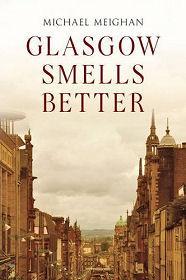 |
Glasgow Smells Better is the second volume of Michael Meighan's recollections of life in a city which today seems far removed from the way it looked, and felt (and smelled) to its residents and to visitors just three or four decades ago. Although it is the second volume, you don't need to have read the first, "Glasgow Smells", to understand or appreciate the recollections and cameos from the Glasgow of (mostly) the 1970s and 1980s which are featured in this book, alongside carefully chosen illustrations ranging from contemporary cartoons to personal photographs and advertising material.
It is also not necessary to have come from Glasgow to appreciate the humour and poignancy that permeates the book, nor to understand the way the real lives of real people were changed dramatically by the march of progress: if a motorway built though the heart of a community can necessarily be called progress. Yes, it is certainly true that people in or from Glasgow are best placed to appreciate this book, and will most readily understand the language, the background and the sense of place: but it is equally true that there are echoes of the Glasgow experience that will chime nearly as well for readers who know other great cities such as Liverpool, and for Scots more widely.
The book's title is a play on the advertising slogan "Glasgow's Miles Better", which ran from 1983 to 1989 (with a reprise in the mid 1990s). This play on words, which works better in capital letters that allow the "s" more easily to seem shift from the end of the first word to the start of the second, was probably one of the most successful advertising or PR campaigns of the last century. It certainly helped alert the world to the fact that the dark satanic Glasgow of the early and middle 1900s was turning into something altogether more attractive: give or take the odd urban motorway.
So this is a book about communities and the places they lived in; about music; about drink and pubs; about studying, work and "neds"; and about the defining element of much of Glaswegian society at the time, "the kerry oot". The sense and spirit of the book is best summed up by the author on page 33: "We didn't really see the creation of the new model cities. We never really appreciated Cumbernauld. We didn't notice that our past was being removed. We didn't know that the plastic phone and the polyethylene mug would be our downfall. We didn't see the last ship going down the Clyde or the last car out of Bathgate. Maybe the Proclaimers did."
InformationPaperback: 126 pagesAmberley Publishing www.amberley-books.com 25 February 2011 ISBN-10: 1445602660 ISBN-13: 978-1445602660 Size: 23.4 x 16 x 0.8 cm Buy from Amazon (paid link) Visit Bookshop Main Page |
